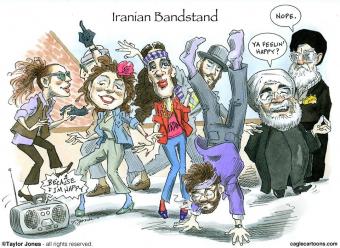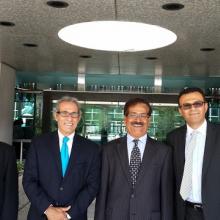No Happy outcome for Happy in Islamic Republic
Being arrested in Iran for what is considered “ordinary” everywhere else in the world is nothing new. Young people have been arrested in Tehran and other cities of Iran for the most mundane matters every single day during the past thirty-five years. Then what is new about the arrest of the six youngsters who danced to Pharrel Williams’ “Happy” in Tehran? And why does this matter so much to the advocates of the Rouhani Administration that they even misleadingly use the President’s last-year tweet1 as to it being the people’s right to be happy in order to show his support for them? As a matter of fact, the arrest of these “happy” people has drawn such a remarkable response from the media worldwide that I believe it merits closer investigation.
The basic thesis is, through staging numerous orchestrated and well-rehearsed events and campaigns such as showing youngsters dancing to “Happy” and asking women to post their hejabless pictures on the Facebook page “My Stealthy Freedom”, the Rouhani Administration and its advocates around the world seem to be intending to demonstrate that Rouhani has made good on his electoral promises as to slackening the immense state pressure on the sociocultural sphere in Iran. The video showing six Iranian youngsters dancing a carefree dance to Pharrel Williams’ popular song, “Happy”, on a rooftop in Tehran was released in YouTube around a month ago. The initial impression was that this video was a “homemade” production. Soon after, an unusual wave of media attention was directed to this video. In an interview with IranWire2, one of the kids who had danced to the song in the video stated that the clip had been made with the aim of promoting the idea that Iran is a better place than what many people in other parts of the world think.
In addition, Reyhaneh Taravati, the art director of this video who was recently arrested and then released on bail, had earlier criticized those who intend to show the situation in Iran as
“dark”; and produced as evidence the very fact that a number of kids had been able on their own to release such a video while living in Iran. However, it was later revealed that the video was not homemade, and that the director of the video was none other than Sasan Soleymani, the very person who had made Rouhani’s presidential campaign clip and had chosen purple as his electoral campaign color.
Parallel to this, on May 3, 2014, a campaign was launched on Facebook by the Iranian journalist, Masih Alinejad3, named “My Stealthy Freedom”4. This campaign encourages Iranian women to unveil in desolate places when there is nobody around, take pictures of themselves, and post them on the said Facebook page, hence the adjective “stealthy”. However, Alinejad also claims that the word stealthy is used on purpose in order to raise awareness about the fact that women are discriminated in Iran.
This campaign also drew an unusual media response, as the page received more than 200,000 “Likes” in just a couple of days and the news of it was widely covered in many prestigious online journals and newspapers around the world in almost the same tabloid format containing very similar details. As one commentator, Mohsen Behzad Karimi, has suggested5, a considerable fortune and a good deal of connection are likely to have gone into this campaign. However, Alinejad who has strong affiliations with the reformist party6 in Iran that incidentally proved to be the main supporter of Rouhani in his electoral campaign last year, claims that the campaign is “spontaneous”, i.e. it does not receive funding and support from any organizations.
These said, the truth is, it will soon be one year since Rouhani has taken office as President. In order to attract voters, he had made a considerable number of liberal-sounding promises the most important of which focused on the granting of social freedoms to people, easing of the sanctions on Iran, and boosting Iranian economy. However, the totality of the system has not budged even an inch toward easing the pressure on the civil society and especially the women.
The Morality Police still haunts public places to arrest the women who are regarded as not conforming to the “Islamic” dress code; the writers and artists are still censored or banned from work; and the protestors are still arrested and kept in custody. The violation of human rights in Iran continues full-steam. Last week, when Rouhani denounced Internet censorship and
dubbed it a “cowardly means” to fight against the West’s “cultural invasion”, the conservatives close to the Supreme Leader retorted by calling censorship an instrument for protecting the Islamic Revolution.
On the other hand, despite engaging in protracted negotiations with the world powers over the Iran nuclear issue, Rouhani practically has not been able to ease the sanctions on Iran and boost the exhausted economy. Also, his subsidy program has proved a near disaster. Added to these is the new price of the already-expensive gasoline that almost doubled on April 25, 2014. Therefore, as Rouhani is under intense pressure from both inside and outside of the country almost one year into his presidency, the voters are beginning to lose confidence in him and realize that he has not been and will probably not be able to deliver on his initial promises. Disillusionment is dawning upon the people of Iran.
It is to be mentioned that none of this had gone without a warning. For instance, as soon as the Happy video appeared on the net, Reza Parchizadeh, a political analyst and scholar at Indiana University of Pennsylvania, warned against being fooled by such a propaganda piece and called it an attempt by the Rouhani Administration and its advocates to show to the world that they have made good on their promises. As he later wrote on his Facebook page7.: “These days it seems that there is a covert war going on between the reformist faction and the conservative faction of the Islamic Republic with the people being its cannon fodder. The regime has reached a point where both sides sacrifice people for their own sake: one side encourages the people to do unconventional things to show that the situation has changed and the other side suppresses them to show that nothing has and neither is going to change!”
As such, in my opinion, events and campaigns like these, while claiming to be or regarded as protest against the Islamic Republic, in fact prove to put up caricatures of protest. Whereas in Tunisia and Egypt the social media were employed in order to mobilize the people to protest in public and to overthrow tyrannical regimes, campaigns and events like the ones studied in this article only scare away the people from any public protest by directing them to do the undoable far from the public eye. However, one does not achieve freedom by dancing on rooftops and unveiling in desolate places. Freedom is only accomplished by standing eye to eye with the forces of oppression.
Avideh Motmaen-Far is a practicing Osteopath based in Canada.
Opinions contained within the article is of the author and not necessarily representative of Iran Roundtable
Iran Roundtable publishes these articles for the sole purpose of disseminating information to stimulate discourse, awareness and diversity of issues.
- 1. "#Happiness is our people's right. We shouldn't be too hard on behaviors caused by joy." 29/6/2013
- 2. جوانان ایرانی با آهنگ فارل در پشت بام خانه شان می رقصند
- 3. Masih Alinejad
- 4. My Stealthy Freedom آزادی یواشکی زنان در ایران
- 5. پشت پرده کمپین آزادیهای یواشکی
- 6. Iranian reform movement
- 7. Reza Parchizadeh on Face Book


